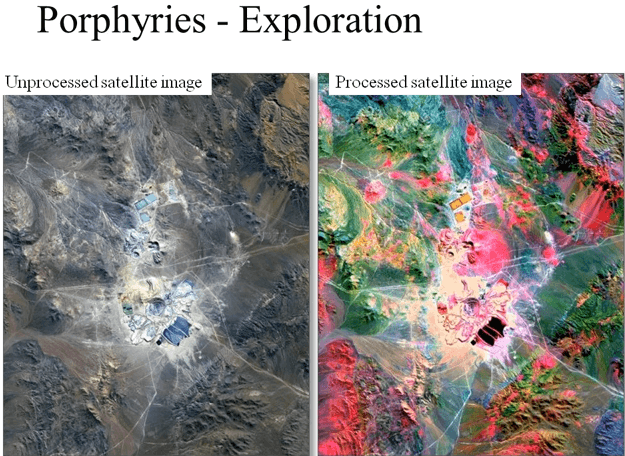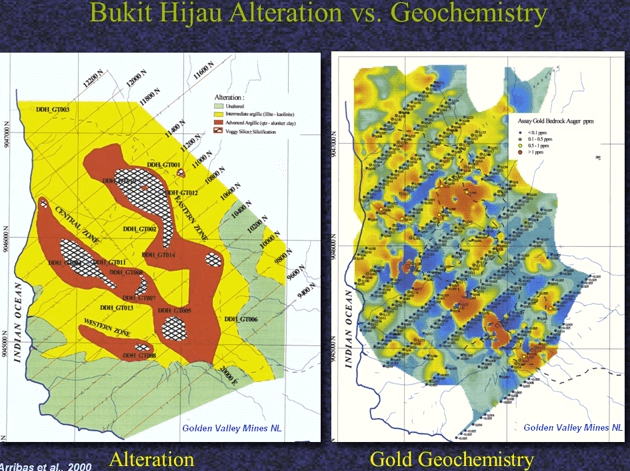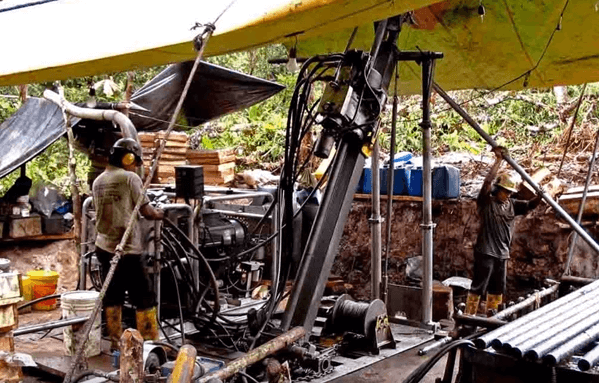 Many of the techniques are similar to those, have described for other deposit types. We need to start by focusing our efforts in areas where there is evidence of major felsic to intermediate volcanism, as it’s this volcanism that drives the epithermal systems. We also needed to find an area that has not been too deeply eroded or else any epithermals would have already been removed. Multispectral analysis from airborne or satellite images may be able to detect wall rock alteration, obviously low- sulfidation epithermal veins with their limited wall rock alteration will not be found like this but it’s a valuable tool for high- sulfidation epithermals.
Many of the techniques are similar to those, have described for other deposit types. We need to start by focusing our efforts in areas where there is evidence of major felsic to intermediate volcanism, as it’s this volcanism that drives the epithermal systems. We also needed to find an area that has not been too deeply eroded or else any epithermals would have already been removed. Multispectral analysis from airborne or satellite images may be able to detect wall rock alteration, obviously low- sulfidation epithermal veins with their limited wall rock alteration will not be found like this but it’s a valuable tool for high- sulfidation epithermals. These images from my earlier talk on porphyry exploration, with exploration for high- sulfidation systems we’re looking for the same sort of alteration as with porphyries, in other words silicic, argillic and advanced argillic silicification. These show up as the pink spots on the image on the right. This is a similar multi-spectral image over the goldfield area in Nevada, a typical high- sulfidation epithermal system.
These images from my earlier talk on porphyry exploration, with exploration for high- sulfidation systems we’re looking for the same sort of alteration as with porphyries, in other words silicic, argillic and advanced argillic silicification. These show up as the pink spots on the image on the right. This is a similar multi-spectral image over the goldfield area in Nevada, a typical high- sulfidation epithermal system.  The highlighted areas is where the ground exploration will obviously be focused.
The highlighted areas is where the ground exploration will obviously be focused.
Once a clear area of hydrothermal alteration has been located, exploration moves to the ground phase, usually beginning with a combination of mapping- to confirm the alteration; and geochemistry- to identify the best targets for drill testing. Remember that in epithermals we may have a significant vertical zonation, so that low grade surface do not necessarily mean that the system is barren at depth. Here’s the result of alteration mapping on the left and soil geochemistry on the right over the same area of the Bukit Hijau property in Indonesia.  Note how the highest gold geochemistry on the right hand image roughly corresponds with vuggy silica alteration to hatched pattern on the left had image. Because of the limitations of surface geochemistry, geophysics may also be used to identify buried vuggy silica or disseminated sulphides that may be associated with mineralization.
Note how the highest gold geochemistry on the right hand image roughly corresponds with vuggy silica alteration to hatched pattern on the left had image. Because of the limitations of surface geochemistry, geophysics may also be used to identify buried vuggy silica or disseminated sulphides that may be associated with mineralization.  This shows a series of IP traverses at Bukit Hijau with the red high resistivity highlighting the vuggy silica in 3 dimensions. The final stage of exploration as usual involves the drill testing.
This shows a series of IP traverses at Bukit Hijau with the red high resistivity highlighting the vuggy silica in 3 dimensions. The final stage of exploration as usual involves the drill testing.  This is a core rig drilling at the Fruta del Norte deposit in Ecuador.
This is a core rig drilling at the Fruta del Norte deposit in Ecuador.
Summarizing the take away points for epithermal deposits. So, here are the key points to remember about epithermals:
- they form above or laterally to porphyry systems
- they are the roots of old hot springs
- most are very recent( in other words tertiary or 50 years or less
- there are three main types and each have their own characteristics:
- Firstly the high-sulfidation
- Mainly gold with minor silver of copper
- They can be very large
- They are often T-shaped due to control by steep structures and flat lying host rocks
- Their roots may extend to more than 1000 meters in depth ( although there usually are less than this )
- They are generally low grade with disseminated mineralization- so they are likely to be mined by open pit
- Low- sulfidation epithermal
- Are mainly gold rich, minor silver and mercury with them
- They are usually small to moderate in size but they are generally high-grade and form relatively narrow steeply dipping veins
- The depth is limited by a boiling zone which is seldom more than about 350 meters of vertical extent
- They are likely to be mined underground, unless there is a swarm of veins in which case they might become open pit targets
- Finally, intermediate- sulfidation epithermal
- Are gold rich near the top, carrying more silver and then dominantly lead, zinc rich at depth
- Mineralization usually occurs in steep veins but it may have flat splays as at Pitarrilla
- The veins may be long and continuous
- Silver- lead- zinc mineralization can extend to significant depths, for example at Fresnillo lead-zinc extends from about 300 meters right down to about 900 meters depth
- Intermediate sulfidation Like low-sulfidation are generally mined from underground, although the flat portions can be open pitted as well.
